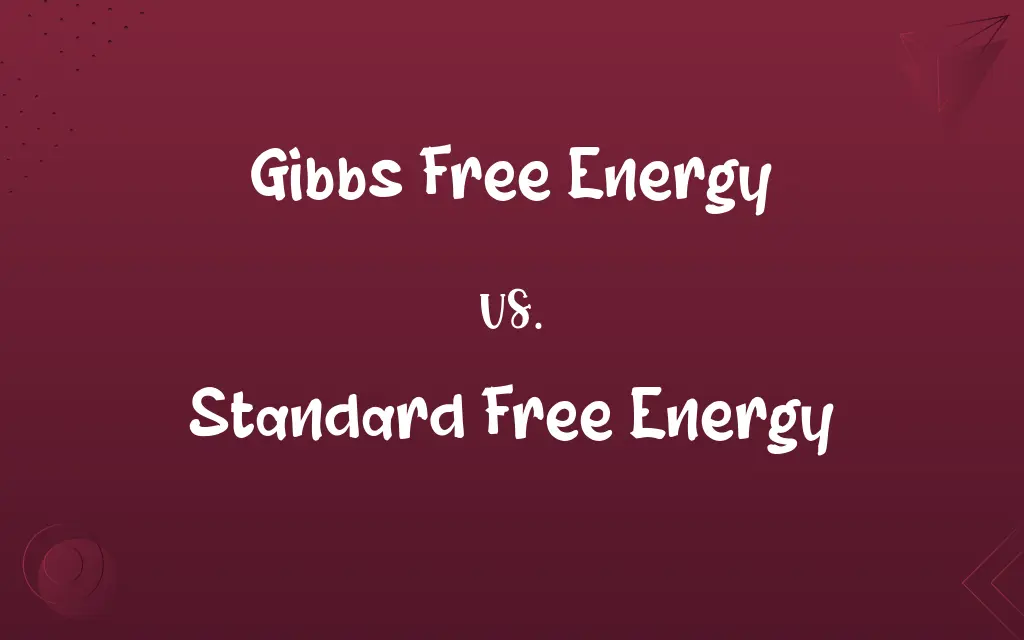Gibbs Free Energy vs. Standard Free Energy: Know the Difference

By Shumaila Saeed || Published on January 7, 2024
Gibbs Free Energy is an energy in a system available to do work. Standard Free Energy is a gibbs Free Energy under standard conditions (1 atm, 25°C).

Key Differences
Gibbs Free Energy, represented by G, quantifies the maximum amount of work a system can perform at constant temperature and pressure. Standard Free Energy refers to the Gibbs Free Energy calculated under standard conditions: 1 atmosphere of pressure and a temperature of 25°C (298 K).
Shumaila Saeed
Jan 07, 2024
Gibbs Free Energy determines the spontaneity of a process; negative G indicates a spontaneous process. In contrast, Standard Free Energy provides a reference point for comparing the spontaneity of reactions under uniform conditions.
Shumaila Saeed
Jan 07, 2024
The value of Gibbs Free Energy is influenced by temperature, pressure, and the composition of the system. The Standard Free Energy, however, remains fixed for a given reaction at standard conditions, serving as a benchmark.
Shumaila Saeed
Jan 07, 2024
In practical applications, Gibbs Free Energy helps predict the feasibility and extent of chemical reactions. Standard Free Energy, meanwhile, is crucial in thermodynamics for calculating equilibrium constants and understanding reaction tendencies.
Shumaila Saeed
Jan 07, 2024
Gibbs Free Energy is a dynamic measure, changing with the system's conditions. Standard Free Energy, by definition, is a static measure, providing a stable point for comparison across different reactions.
Shumaila Saeed
Jan 07, 2024
ADVERTISEMENT
Comparison Chart
Definition
Energy available for work in a system
Gibbs Free Energy under standard conditions
Shumaila Saeed
Jan 07, 2024
Conditions
Varies with system's conditions
Standard conditions (1 atm, 25°C)
Shumaila Saeed
Jan 07, 2024
Dependence
Temperature, pressure, composition
Fixed for a given reaction at standard conditions
Shumaila Saeed
Jan 07, 2024
ADVERTISEMENT
Measurement
Dynamic, changes with conditions
Static, specific to standard conditions
Shumaila Saeed
Jan 07, 2024
Role in Thermodynamics
Assessing spontaneity and equilibrium
Reference point for equilibrium constants
Shumaila Saeed
Jan 07, 2024
Units
Joules or calories
Joules or calories, specific to standard conditions
Shumaila Saeed
Jan 07, 2024
Use in Calculations
Real-time reaction analysis
Theoretical reaction analysis
Shumaila Saeed
Jan 07, 2024
ADVERTISEMENT
Gibbs Free Energy and Standard Free Energy Definitions
Gibbs Free Energy
Measure of a system's capacity to do work.
The negative Gibbs Free Energy indicated the reaction was spontaneous.
Shumaila Saeed
Dec 28, 2023
Standard Free Energy
Used to compare the spontaneity of reactions under uniform conditions.
We used Standard Free Energy to evaluate which reaction was more favorable.
Shumaila Saeed
Dec 28, 2023
Gibbs Free Energy
Indicator of a reaction's position relative to equilibrium.
Zero Gibbs Free Energy meant the reaction was at equilibrium.
Shumaila Saeed
Dec 28, 2023
Standard Free Energy
Reference point in thermodynamics for standard conditions.
In our study, we referred to the Standard Free Energy values of various reactions.
Shumaila Saeed
Dec 28, 2023
Gibbs Free Energy
Reflects the feasibility of a chemical reaction.
The low Gibbs Free Energy suggested the reaction would proceed readily.
Shumaila Saeed
Dec 28, 2023
Standard Free Energy
Gibbs Free Energy of a reaction under standard conditions.
The Standard Free Energy provided a baseline for comparing different reactions.
Shumaila Saeed
Dec 28, 2023
Gibbs Free Energy
Determines whether a process is spontaneous at constant temperature and pressure.
With a positive Gibbs Free Energy, the process was non-spontaneous.
Shumaila Saeed
Dec 28, 2023
Standard Free Energy
Predicts the tendency of reactions at standard conditions.
The negative Standard Free Energy indicated a likely spontaneous reaction.
Shumaila Saeed
Dec 28, 2023
Gibbs Free Energy
Quantifies available energy in a system for work.
The high Gibbs Free Energy represented a large amount of usable energy.
Shumaila Saeed
Dec 28, 2023
Standard Free Energy
Basis for calculating equilibrium constants.
The Standard Free Energy helped us calculate the reaction's equilibrium constant.
Shumaila Saeed
Dec 28, 2023
Repeatedly Asked Queries
What does a negative Gibbs Free Energy indicate?
A negative Gibbs Free Energy indicates that a process or reaction can occur spontaneously.
Shumaila Saeed
Jan 07, 2024
Is Gibbs Free Energy temperature-dependent?
Yes, Gibbs Free Energy is temperature-dependent, as seen in its formula.
Shumaila Saeed
Jan 07, 2024
What defines Standard Free Energy?
Standard Free Energy refers to the Gibbs Free Energy of a reaction carried out under standard conditions (1 bar, 25°C).
Shumaila Saeed
Jan 07, 2024
What is the symbol for Standard Free Energy?
Standard Free Energy is often denoted as ΔG∘.
Shumaila Saeed
Jan 07, 2024
What does positive Standard Free Energy mean?
Positive Standard Free Energy means the reaction or process is non-spontaneous under standard conditions.
Shumaila Saeed
Jan 07, 2024
What role does Gibbs Free Energy play in biological systems?
In biological systems, Gibbs Free Energy helps understand energy changes in biochemical reactions.
Shumaila Saeed
Jan 07, 2024
Can Standard Free Energy be zero?
Yes, if a reaction is at equilibrium under standard conditions, its Standard Free Energy change is zero.
Shumaila Saeed
Jan 07, 2024
What is Gibbs Free Energy?
Gibbs Free Energy is a thermodynamic property indicating the amount of useful work obtainable from a thermodynamic system at constant temperature and pressure.
Shumaila Saeed
Jan 07, 2024
Are standard conditions always required for Standard Free Energy?
Yes, Standard Free Energy calculations assume reactions under standard conditions.
Shumaila Saeed
Jan 07, 2024
Is Standard Free Energy used in industrial applications?
Yes, it's used to predict the feasibility of chemical processes in industry.
Shumaila Saeed
Jan 07, 2024
Does Standard Free Energy consider kinetic factors?
No, Standard Free Energy is a thermodynamic concept and doesn't account for reaction kinetics.
Shumaila Saeed
Jan 07, 2024
Is the concept of Standard Free Energy applicable to non-standard conditions?
The concept is specific to standard conditions, but adjustments can be made for non-standard conditions using the reaction quotient.
Shumaila Saeed
Jan 07, 2024
What is the significance of Gibbs Free Energy in phase transitions?
Gibbs Free Energy helps in determining the conditions under which a substance will change its phase.
Shumaila Saeed
Jan 07, 2024
Can Gibbs Free Energy predict reaction direction?
Yes, Gibbs Free Energy can predict the favored direction of a chemical reaction.
Shumaila Saeed
Jan 07, 2024
Does Standard Free Energy change with concentration?
No, Standard Free Energy is calculated assuming standard-state concentrations.
Shumaila Saeed
Jan 07, 2024
How does pressure affect Gibbs Free Energy?
Gibbs Free Energy is generally calculated at constant pressure, so variations in pressure can affect its value.
Shumaila Saeed
Jan 07, 2024
How does Gibbs Free Energy relate to reaction spontaneity?
A negative Gibbs Free Energy implies spontaneity, while positive values imply non-spontaneity.
Shumaila Saeed
Jan 07, 2024
Share this page
Link for your blog / website
HTML
Link to share via messenger
About Author
Written by
Shumaila SaeedShumaila Saeed, an expert content creator with 6 years of experience, specializes in distilling complex topics into easily digestible comparisons, shining a light on the nuances that both inform and educate readers with clarity and accuracy.








































































